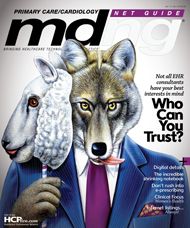Digitally Detailing Doctors
Expanded use of electronic detailing and other portable media would offer drug marketers and physicians opportunities to connect outside of the traditional in-person rep visits.
A neatly groomed man in his late 20s sat next to me on a recent flight from Philadelphia to Los Angeles. As soon as he could, the man powered on his laptop and donned a pair of headphones. An episode of Scrubs soon appeared on his bright and sharp LCD. I could tell he was multi-tasking by the way he fingered his touchpad, expertly toggling back and forth between reading documents and watching the television show.
Thirty minutes into the flight, we began to make small talk about our trip and what we did for a living. “Ben,” a second-year resident in anesthesiology at a major medical institution on the East Coast, was flying to LA to see his girlfriend, also a resident. I immediately asked about his sleek and slim laptop, which had drawn my initial interest. As Ben demonstrated the basic features of his new MacBook, I noticed that he had been reading medical articles with heavy text in .PDF format.
When I told Ben that I run a pharmaceutical marketing company that provides marketing services like eDetailing for prescription drug brand teams, he laughed and said, “In the old days, I probably would have received this Mac free of charge instead of paying $1,300 myself. Except that it would have had ‘Pfizer’ engraved on the lid.” He then paused and added, “I wrote a beta blocker the other day for a patient with congestive heart failure. I had no idea about the drug. How are we supposed to learn about all of these drugs that are available?” He then went back to his Mac and another Scrubs episode, which he had purchased and downloaded from the Internet prior to boarding.
Residents like Ben have been entering healthcare at a time when pharmaceutical marketing is at a crossroad—greatly reduced sales forces are struggling to deal with declining access to an increasingly more technology-savvy physician population. According to Health Strategies Group, nearly 40% of physicians are no-see or difficult to access. These physicians will no longer be wooed by an army of attractive and sociable drug reps enticing them with fancy dinner speaker programs and exotic educational retreats plus honoraria like their elders were during the pharma industry’s boom years. Gone are the coffee cups, pens, and pads emblazoned with product logos and marketing slogans. Possibly looming on the horizon are “academic detailers” intended to counteract the drug industry’s marketing and sales efforts, especially at physician offices with substantial numbers of Medicare and Medicaid patients. Time will tell whether the new Congress will resurrect the proposed “Independent Drug Education and Outreach Act of 2008’’ that was introduced last July.
Despite favoring trends, pharma industry Internet spending lags behind that of other industries (3.1% of marketing budget vs. 7.3%), despite the fact that physicians have demonstrated that they want to access drug information online. Searching for medication and treatment information is the number-one reason healthcare professionals use the Web. The second-most popular reason physicians use the Internet is for online access to medical journals, a trend that’s expected to continue growing at double-digit rates. Industry surveys indicate that 89% of physicians use the Internet for professional purposes (on average 9.8 times per week).
Back to Ben. I could not help but think about the entertainment industry’s marketing practices as compared to the drug industry. First, movies are premiered at theaters. Then they come on cable or pay-per-view television before becoming available on DVDs for rental or purchase. And now movies are downloadable for convenient viewing. The content is consistent yet available via different formats to suit various customers. What if Ben had drug education content that was portable that he could review during the five-hour flight? Would he watch video clips of a key opinion leader? Could he have learned about beta and calcium channel blockers and diuretics and ACE inhibitors even just for a few minutes during the flight?
Digital drug marketing and educational content that is available in various formats would make learning more interactive. Expanded use of electronic detailing and other portable media would offer drug marketers and physicians opportunities to connect outside of the traditional in-person rep visits. Physicians who would prefer to receive electronic drug information, for old and new medicines, need to let pharma companies know that the time has come to embrace new technologies that provide better options for busy doctors.
Quang X. Pham is the founder and president of Lathian Health.
